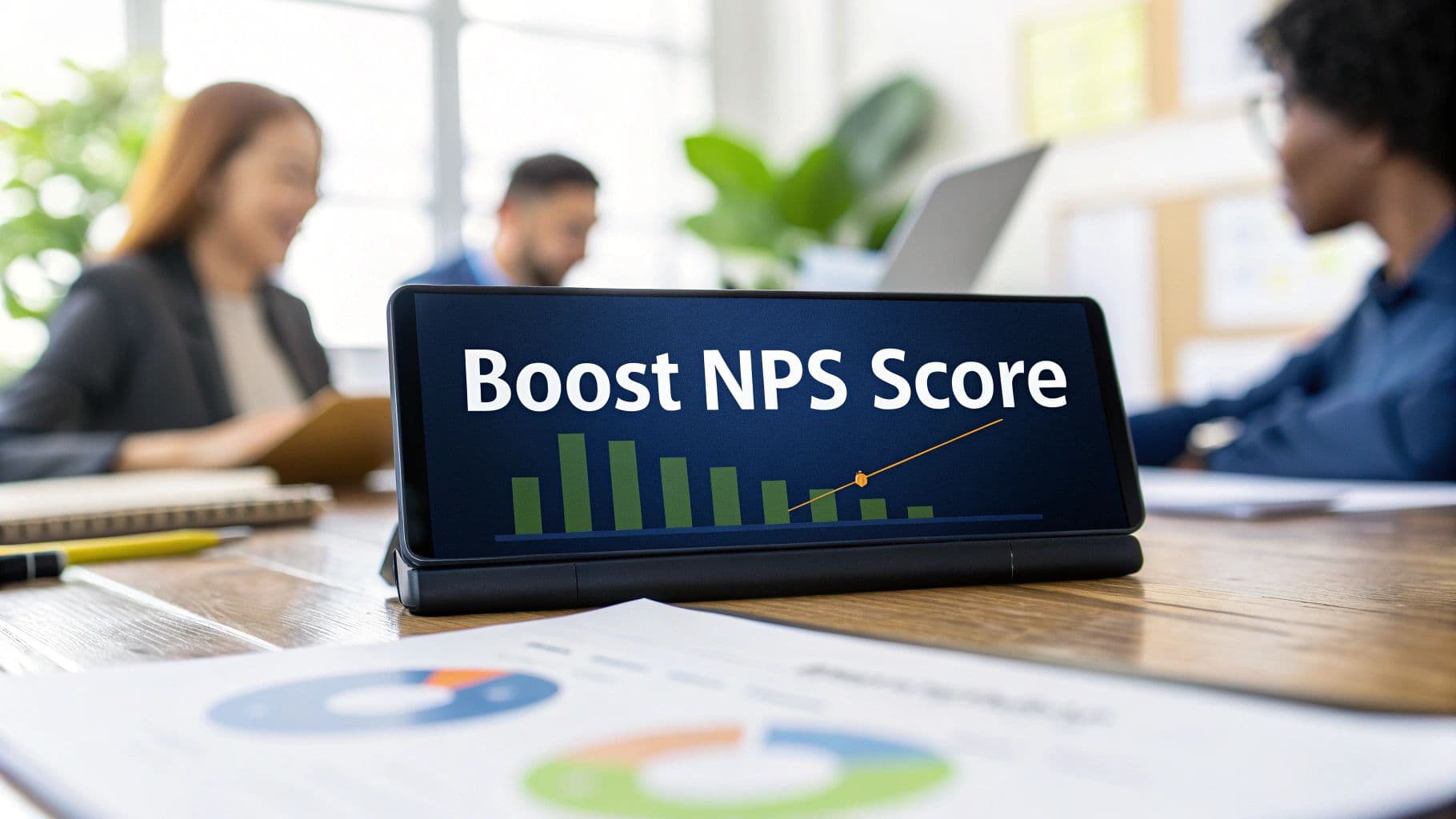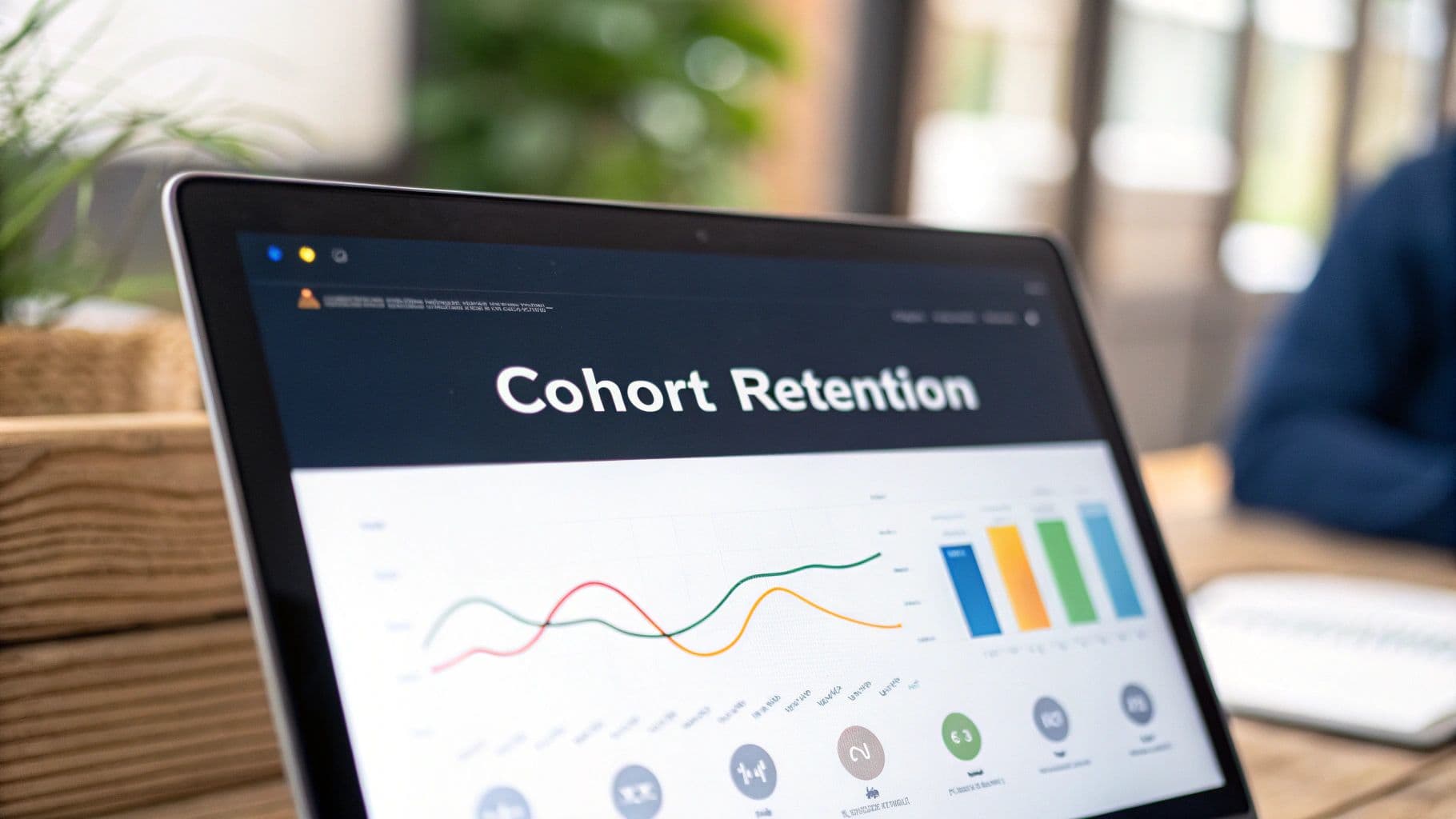Your Guide to a Technical Roadmap Template
Build a better technical roadmap template with this guide. Align your tech team, manage stakeholders, and link your strategy directly to business success.

A technical roadmap template isn't just a document; it's the strategic compass that points your engineering efforts in the right direction. It translates those high-level company goals into concrete, actionable plans for your technical teams. When done right, it prevents wasted cycles and misaligned priorities, bringing much-needed clarity to everyone from individual engineers to the C-suite.
Why Your Tech Strategy Needs a Roadmap
It's easy to think of a technical roadmap as just another timeline, but that's a common mistake. A well-designed template is so much more than that. It’s a powerful communication tool that creates a direct line between the day-to-day work of your engineering team and the company's biggest, most ambitious goals. Think of it as the single source of truth that keeps everyone on the same page.
When your development team understands the why behind their work, they build better products. A roadmap provides that crucial context. It shows exactly how that new microservice or that critical infrastructure upgrade helps achieve a larger business objective, like boosting customer retention by 15%.
Bridge the Gap Between Tech and Business
Without a clear roadmap, a dangerous gap can open up between technical work and business value. I've seen it happen: development teams get drawn to technically interesting projects that have little business impact, while stakeholders are left wondering why key revenue-driving features are constantly delayed. This kind of misalignment breeds frustration, wastes resources, and leads to a ton of missed opportunities.
A structured roadmap acts as a bridge, translating complex technical initiatives into outcomes that business leaders actually care about.
It helps you:
- Justify Resource Needs: When you can link a project directly to a specific goal, building a strong case for more budget or headcount becomes much easier.
- Manage Stakeholder Expectations: A visual plan eliminates surprises by setting clear expectations about what will be delivered and when.
- Align Cross-Functional Teams: Your sales, marketing, and product teams can finally see how the technical foundation is being built to support their own work.
The screenshot below from Airtable perfectly illustrates this common struggle—product teams often find it hard to connect their work to clear business outcomes. This is precisely the problem a solid roadmap is designed to solve.

This data really brings home the need for tools that show how product development impacts the bottom line. A good technical roadmap template is the first, most important step toward creating that line of sight.
Drive Alignment and Accountability
At the end of the day, a technical roadmap is more than just a plan; it’s an agreement. It forces alignment between engineering efforts and strategic priorities, making it an indispensable tool for any company that wants to connect its tech initiatives with real business goals. This is especially critical when you realize that 92% of product leaders are now directly on the hook for revenue outcomes.
The Building Blocks of an Effective Tech Roadmap
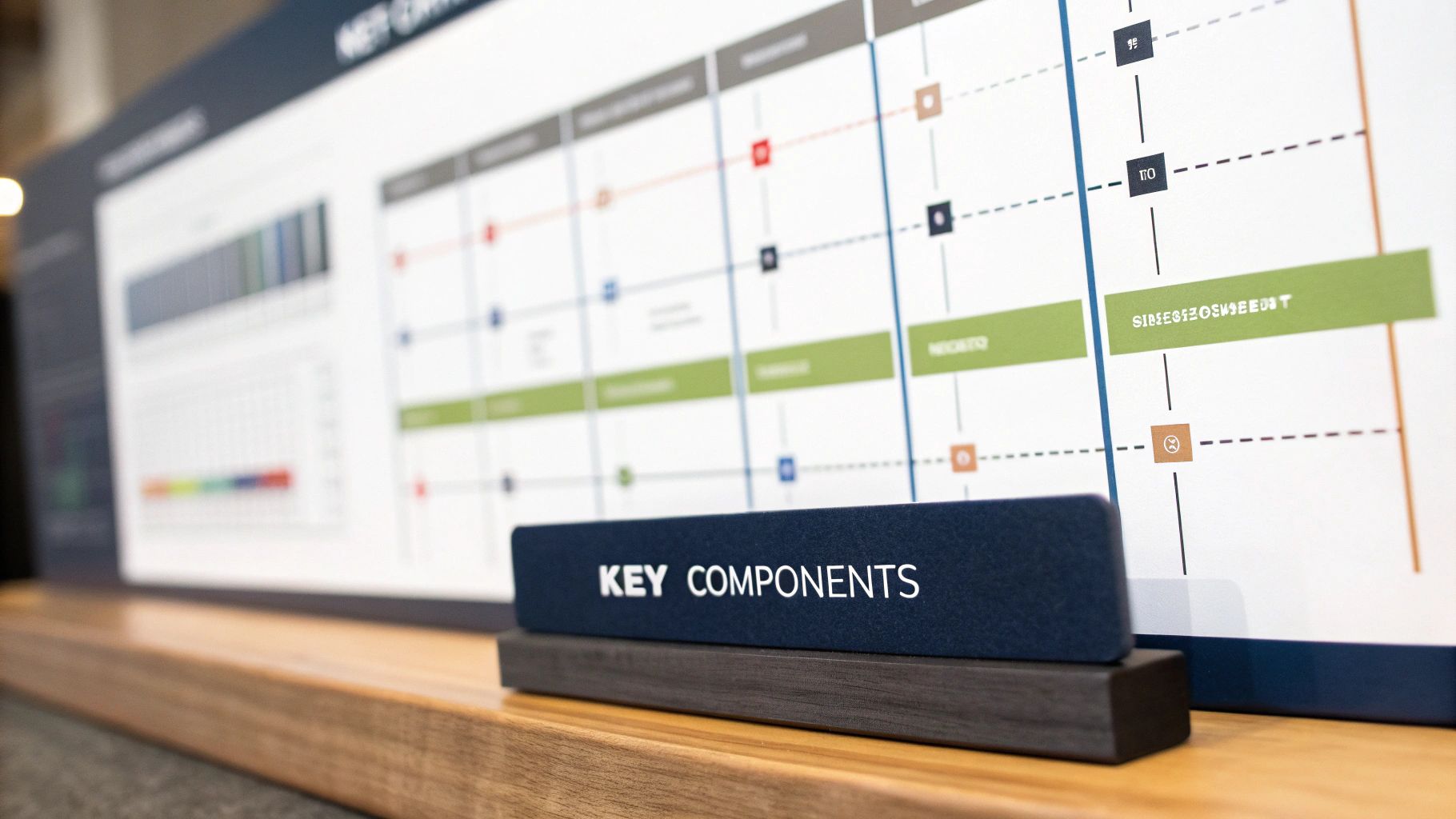
A really effective roadmap tells a complete story. It's the bridge connecting your high-level business strategy to the actual, hands-on technical work required to make it happen. It’s not just a fancy to-do list; it’s a living document made up of several key pieces that all fit together. Getting a handle on these building blocks is the first step toward crafting a technical roadmap template that actually works for your team and your stakeholders.
At the very top, you’ll find your strategic initiatives and themes. Think of these as the big-picture goals, not individual features. For example, a theme could be something broad like "Improve Application Performance" or "Strengthen Data Security."
This approach makes sure every small task contributes to a larger, meaningful objective. It gives your engineers the "why" behind their work, which is incredibly motivating and provides essential context.
Defining Clear Objectives and Success Metrics
With your high-level themes in place, the next job is to break them down into specific, tangible objectives. And here's the critical part: every single objective needs to be paired with clear, measurable success metrics. Without them, your roadmap is just a collection of good intentions.
Let's stick with the "Improve Application Performance" theme. A solid objective would be "Reduce average API response time." The metric that gives this goal teeth would be something concrete, like, "Decrease average API response time from 500ms to under 200ms by the end of Q3."
That kind of clarity is a game-changer. It turns a vague wish into a specific target the team can rally around and actively measure their progress against.
Before we get into dependencies and resource planning, let's lay out the essential pieces your template will need. Think of these as the non-negotiable columns in your spreadsheet or fields in your project management tool.
Key Components for Your Technical Roadmap Template
Here’s a breakdown of the core elements that should form the foundation of your technical roadmap template. Each one serves a distinct purpose in creating a clear, actionable plan.
| Component | Purpose | Key Outcome |
|---|---|---|
| Themes & Initiatives | Group related work under high-level strategic goals. | Ensures all technical work aligns with business objectives and provides context. |
| Objectives | Define specific, desired outcomes for each theme. | Translates broad strategy into actionable engineering goals. |
| Success Metrics (KPIs) | Provide measurable targets to track progress and define success. | Enables data-driven decisions and demonstrates the impact of engineering efforts. |
| Dependencies | Map out connections and prerequisites between different projects. | Prevents bottlenecks, improves sequencing, and highlights the critical path. |
| Resource Allocation | Assign teams and estimate the capacity needed for initiatives. | Fosters accountability and ensures the roadmap is realistic and achievable. |
| Timeline / Quarters | Set a timeframe for when work is expected to be tackled. | Provides a high-level schedule for stakeholders and helps with planning. |
Having these components built into your template from the start forces the right conversations and ensures nothing critical gets overlooked.
Mapping Dependencies and Allocating Resources
One of the most practical jobs of a technical roadmap is to make dependencies visible. Let's be real—no technical task exists in a vacuum. A new user authentication service might depend on a database upgrade, which itself might require new infrastructure to be provisioned.
Mapping these connections is absolutely critical for preventing bottlenecks and sequencing work in a logical order. It helps you see the critical path and understand which projects will unblock others down the line.
Many modern product roadmap templates do a great job of integrating timelines, dependencies, and priorities. For example, structuring a roadmap around quarters or sprints can visually flag key deadlines for feature completion or beta launches. Seeing how these pieces connect helps you spot potential roadblocks before they become emergencies. You can find some great product roadmap timeline examples on Miro that show how this works in practice.
Finally, your roadmap has to tackle resource allocation. This is where your strategic goals meet the reality of your team's day-to-day capacity.
- Team Assignments: Who owns this initiative? Clearly assigning teams or key people to major roadmap items builds accountability right from the start.
- Capacity Planning: Do we actually have the bandwidth to tackle this in the proposed timeframe? This forces an honest conversation about what’s realistic and what trade-offs need to be made.
- Skill Gaps: Does this project require expertise we don't currently have? Identifying this early on the roadmap gives you time to plan for training, hiring, or bringing in a consultant.
By making sure these building blocks are part of your template, you're creating more than just a document. You're building a powerful tool for alignment, communication, and, most importantly, execution.
Building Your Technical Roadmap From Scratch
Alright, let's get down to actually building this thing. Creating a custom technical roadmap template that works for your company isn't about grabbing a generic file off the internet. It’s about building a process that connects what the business wants to achieve with what your engineers are actually building.
The whole journey starts way before you even think about technology. It starts with strategy. You need a rock-solid understanding of the company's big-picture goals before you can even begin to map out features or infrastructure upgrades. The first question to ask is always: what are the most important business outcomes we need to deliver in the next six to twelve months?
Start With Business Objectives
Every single technical project you take on has to be a direct answer to a business need. Full stop.
Is the company trying to break into a new market in Europe? Your roadmap should probably feature internationalization and localization support. Is the leadership team laser-focused on cutting customer churn by 10%? Then your priorities might shift to crushing technical debt and boosting platform performance.
This alignment is everything. It's the "why" behind every technical decision you make, and it’s how you justify spending time and money to stakeholders who don't live and breathe code.
A fantastic way to nail this down is to get the key leaders from product, sales, marketing, and engineering in a room for a workshop. The mission is simple: agree on the top three to five business objectives for the coming year.
Once those are set, you can start drawing a straight line from them to technical themes.
- Business Goal: "Improve customer retention."
- Technical Theme: "Enhance Platform Stability and Performance."
This simple connection makes sure your engineering efforts are always rowing in the same direction as the rest of the business.
Gather Stakeholder Input and Prioritize Wisely
Now that you have your high-level themes, it’s time to open the floor. Talk to everyone: engineering leads, product managers, the customer support team, even sales. These are the people on the front lines, and they have invaluable insights into customer pain points and hidden opportunities you’d never see from an ivory tower.
Of course, this will generate a massive wish list, and you can't build it all. This is where a good prioritization framework becomes your secret weapon.
Frameworks like RICE (Reach, Impact, Confidence, Effort) or MoSCoW (Must-have, Should-have, Could-have, Won't-have) give you a structured way to evaluate ideas without letting emotions or politics take over. They force you to use data to decide what to tackle first. With RICE, for example, a high-impact, high-reach feature that doesn’t take a ton of effort will naturally float to the top of the list.
The image below gives a great visual of how this flow works, from setting your objectives all the way to assigning people to the work.
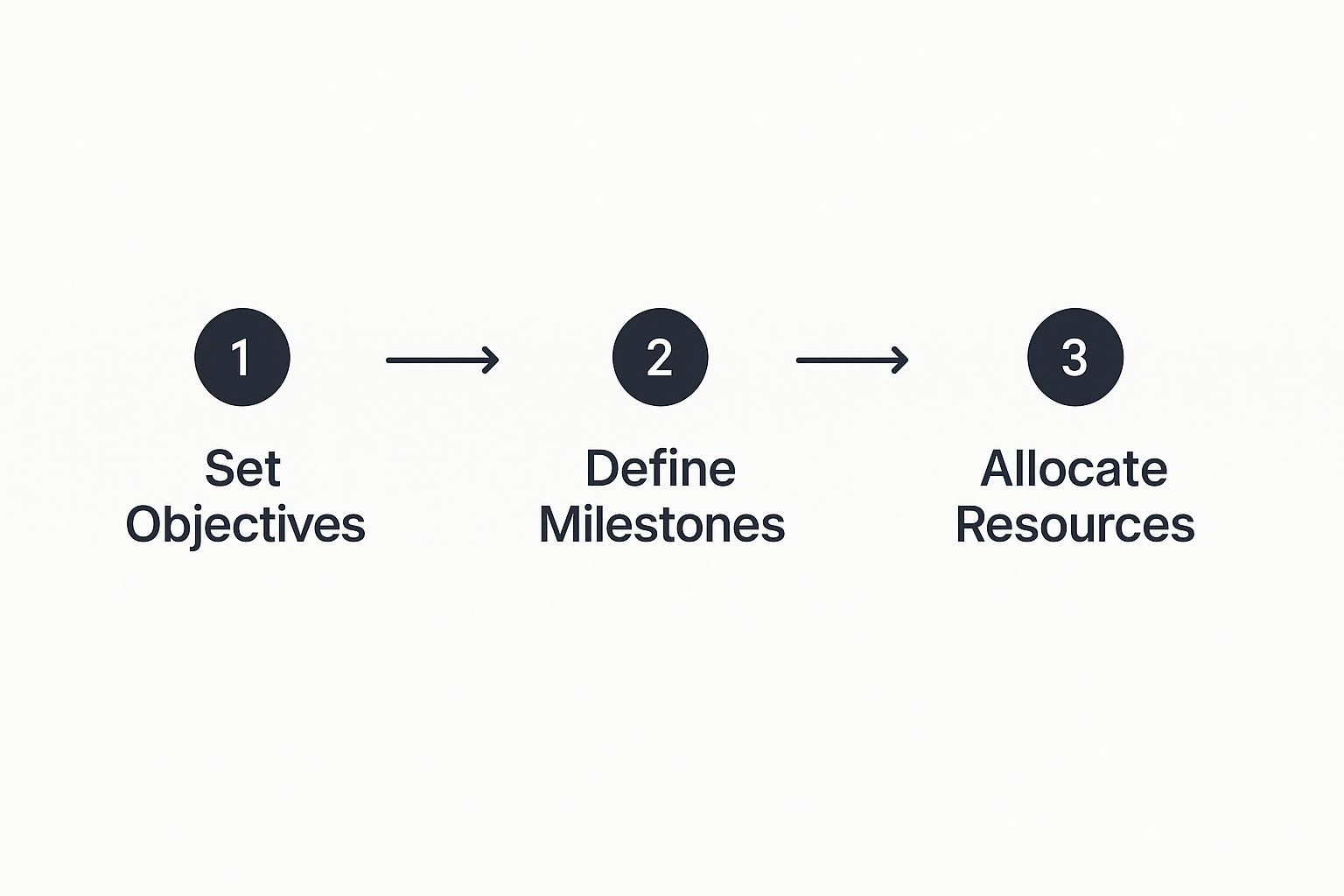
As you can see, defining clear milestones is the critical step that connects your big-picture strategy to the practical reality of resource allocation.
Choose the Right Format for Your Audience
Here's a pro-tip: a one-size-fits-all roadmap view simply doesn't work. The way you present your plan has to change depending on who you're talking to.
- For Executives: They need the 30,000-foot view. A high-level timeline showing major milestones by quarter is perfect. They want to see the big picture and know when to expect major outcomes.
- For the Dev Team: A goal-oriented or theme-based board (think Kanban-style) is far more useful. This view connects their day-to-day tasks to the larger strategic initiatives without getting hung up on exact deadlines.
Your technical roadmap template needs to be flexible enough to handle these different views. A lot of modern roadmapping tools let you toggle between timeline, list, and board formats, which is a lifesaver. If you're looking for ideas on how this looks in the real world, check out these different technology roadmap examples.
Ultimately, building a great roadmap is an exercise in communication. If you start with business goals, prioritize with a system, and tailor your presentation to your audience, you’ll end up with more than just a document. You’ll have a powerful tool that guides your team and proves the strategic value of your work.
Finding the Right Tool for Your Roadmap
A brilliant technical roadmap template is only half the battle; it needs a practical, living home. The tool you choose can either make strategic planning a breeze or turn it into an administrative nightmare. Honestly, it’s less about finding the "best" software and more about finding the right fit for your team's unique workflow and communication style.
A lot of teams kick things off with a simple spreadsheet. It’s familiar, it’s easy, but it quickly becomes a bottleneck. Spreadsheets are static by nature, making them a pain to update, terrible for collaboration, and nearly useless for visualizing complex dependencies. Moving beyond a static file is the first real step toward a functional, dynamic roadmap.
Dedicated Roadmapping Platforms
For teams that are serious about product strategy, dedicated tools like Productboard or Aha! offer a powerful, purpose-built experience. These platforms were built from the ground up for roadmapping, connecting that high-level strategy directly to feature ideas and real customer feedback.
What I love about them is their ability to create different views for different audiences. You can whip up a timeline view for the executive team and then pivot to a theme-based board for the engineers, all from the same data. Their biggest strength is integration—they can pull in data from support tickets and project management systems, creating a single source of truth. The trade-off? They can come with a steeper learning curve and a higher price tag.
Project Management Tools with Roadmap Features
Over the years, familiar tools like Jira and Asana have added some surprisingly robust roadmap features. If your engineering team already lives and breathes in one of these platforms, using its built-in functionality can be incredibly efficient. This approach keeps strategy and execution in the same place, which means less context-switching for everyone.
The real win here is workflow continuity. You can link a roadmap initiative directly to the epics and stories your developers are actively working on. The flip side is that these roadmapping features can sometimes feel more like a glorified project plan. They might not have the nuance for high-level, thematic planning that you'd get from a dedicated tool.
To help you sort through the options, here’s a quick breakdown of the different tool categories.
| Tool Category | Best For | Key Strengths | Potential Drawbacks |
|---|---|---|---|
| Dedicated Software | Product-led organizations needing deep strategic alignment. | Powerful visualization, audience-specific views, deep integrations. | Higher cost, can be complex to set up and manage. |
| Project Management | Teams wanting to link strategy directly to daily execution. | Excellent for task-level tracking, seamless dev workflow. | Can be too tactical, lacking high-level strategic features. |
| Visual Platforms | Collaborative teams that need maximum flexibility for brainstorming. | Unmatched flexibility, great for workshops and visual planning. | Lacks automation, can become messy without strict governance. |
Flexible Visual Collaboration Platforms
Then you have the digital whiteboards of the world, like Miro or FigJam. Their superpower is infinite flexibility. This makes them perfect for the early, messy stages of roadmap creation—think brainstorming sessions, stakeholder workshops, and collaborative prioritization exercises.
You can build a completely custom technical roadmap template that looks and feels exactly how you want it to. But that total freedom can be a double-edged sword. These tools lack the automation and structure of dedicated software, which means you're on the hook for manually updating progress and keeping the document from becoming a chaotic mess.
For a deeper look into the software landscape, our guide on the best tools for product managers offers a comprehensive look at what's available.
Crafting a Roadmap for Your Data and Analytics
Think of a technical roadmap, and you probably picture a timeline for shipping new software features. But in a world awash with data, one of the most vital roadmaps you can build is one dedicated entirely to your data and analytics strategy. This isn't just a backlog; it's a strategic plan that clarifies your priorities, justifies those big infrastructure investments, and directly connects your team's work to real business outcomes.
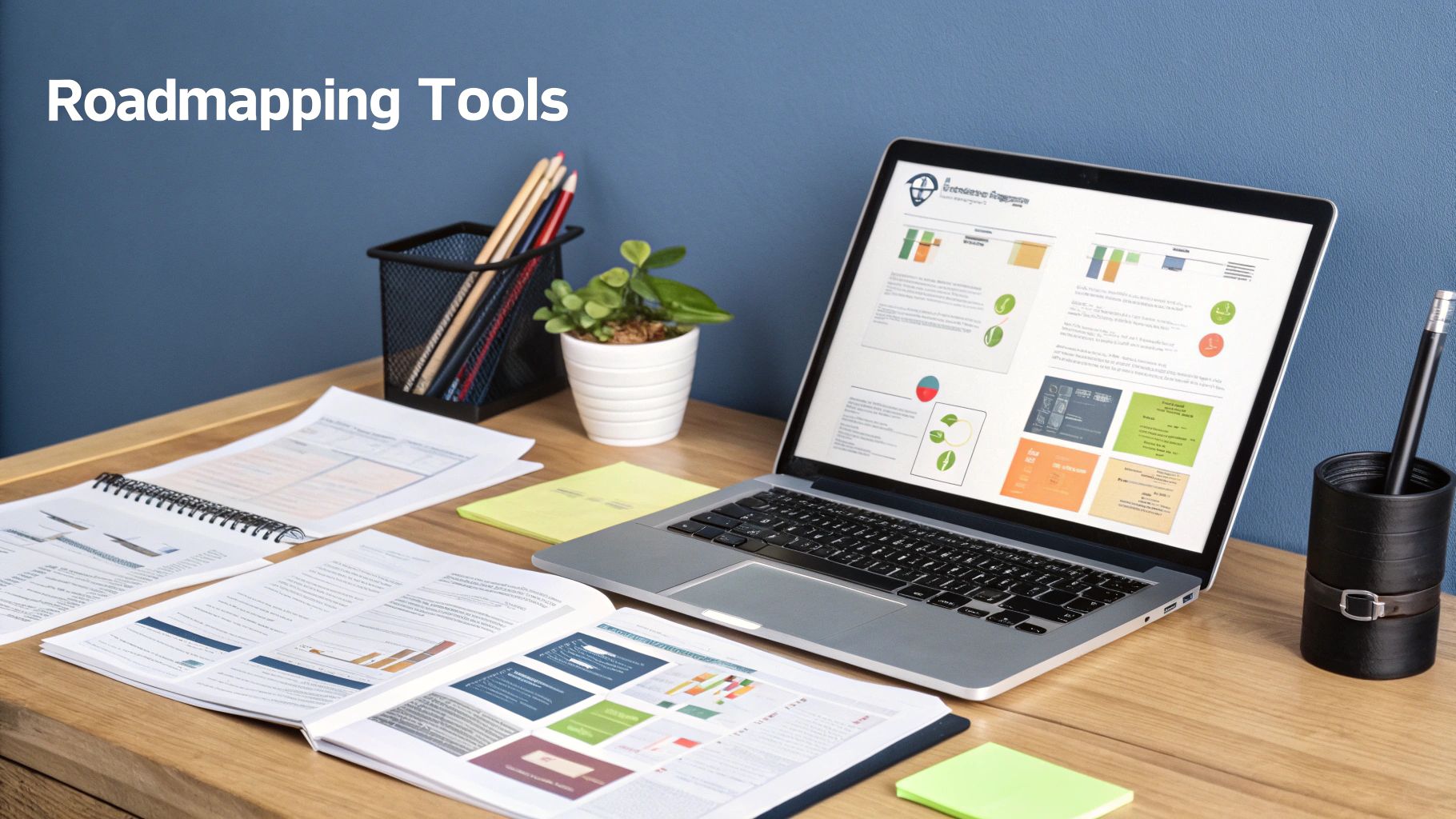
A proper data roadmap goes way beyond just listing new dashboards. It addresses the entire data lifecycle—from how you'll get your hands on new data sources to the foundational upgrades needed to process it all without your servers catching fire.
What Goes Into a Solid Data Roadmap?
When you’re sketching out a technical roadmap template for your data initiatives, it needs a few special ingredients that you wouldn't find in a standard product roadmap. These are the pillars that will support your organization's data maturity over the long haul.
Make sure your roadmap clearly spells out these four areas:
- Data Sourcing & Integration: Where is the data coming from? This section should detail plans for tapping into new third-party APIs, connecting to internal databases, or even onboarding customer data.
- Infrastructure & Tooling: What technology will power all of this? This is where you map out everything from your choice of a data warehouse, like Snowflake, to the visualization tools your team will use, such as Tableau.
- Data Governance & Quality: How are you going to keep the data clean and secure? This is about defining who gets access to what, establishing data quality checks, and agreeing on official definitions for key business metrics.
- Analytics & Reporting Outputs: What are you actually going to build? This part outlines the tangible deliverables, like new executive dashboards, automated weekly reports, or even predictive models that forecast sales.
Covering these bases ensures your plan is grounded in reality, connecting the dots from raw data ingestion all the way to delivering insights that people can actually use. To get a better handle on building these capabilities from the ground up, check out this deep dive into https://www.sigos.io/blog/enterprise-data-analytics.
From Manual Mayhem to Automated Insight
Let’s imagine a marketing agency drowning in manual client reporting. Every month, their analysts burn days just copying and pasting data from a dozen different platforms into spreadsheets. There's almost no time left to find any actual insights.
Here’s what their data roadmap could look like to fix this mess:
- This Quarter (Q1): Centralize Core Client Data. The first big rock is to get a data warehouse in place. The goal is to consolidate everything from Google Analytics, their CRM, and all the various ad platforms into one single source of truth.
- Next Quarter (Q2): Automate Reporting Workflows. With the data in one place, the next move is to bring in a business intelligence (BI) tool. They’ll connect it to the warehouse and start building automated, self-refreshing dashboards for each client. No more spreadsheets.
- The Quarter After (Q3): Introduce Predictive Analytics. Now that they have a solid, reliable data foundation, they can finally get ahead of the game. The team can start developing models to forecast client performance or spot opportunities before the client even asks.
This kind of methodical approach is quickly becoming the norm. Data strategy roadmaps are so effective that over 7,000 agencies have already made the switch from manual reporting to a more strategic, roadmap-driven model. It forces analytics teams to tie their work directly to business priorities, steering clear of the all-too-common trap of collecting data for data's sake.
This journey transforms a chaotic, reactive process into a well-oiled machine that consistently delivers value. It's how you prove the ROI of your data team and build much stronger, data-informed relationships with every stakeholder you work with.
Common Questions About Technical Roadmaps
Even the most perfect technical roadmap template is going to spark a few questions. That's a good thing. It means your team is engaged. It's crucial to remember that a roadmap isn't a static plan set in stone; it's a living document that steers your strategy.
Let's dive into some of the questions I hear all the time from teams trying to get this right.
How Often Should I Update My Technical Roadmap?
There's no single magic number here—it really comes down to the rhythm of your business and industry. For most teams, a quarterly review hits the mark. This cadence usually syncs up nicely with the company's broader business planning, giving you a natural checkpoint to see what's changed and adjust your priorities.
But what if you're on a fast-paced agile team? A three-month wait can feel like a lifetime. In that scenario, a quick, informal monthly check-in can make all the difference. You're not looking to tear up the whole plan, just make minor course corrections based on new customer feedback or a sudden shift in the market.
The real value of a technical roadmap is in its relevance. It needs to be a dynamic guide, an accurate reflection of where you're headed right now, not where you thought you'd be six months ago.
What's the Real Difference Between a Technical and a Product Roadmap?
This one trips up a lot of people. Think of it this way: the product roadmap is all about the "what" and "why" from the customer's point of view. It’s the story you tell about new features, user benefits, and how you plan to win in the market.
The technical roadmap, on the other hand, is the essential "how." It's the blueprint that outlines the architecture, infrastructure, and technical enablers needed to make that product vision a reality. They're two sides of the same coin; if they're not in sync, you're heading for trouble.
How Detailed Should This Thing Actually Be?
It's tempting to cram every little detail in, but that's a trap. Your roadmap needs to stay at a strategic altitude. Focus on the big picture: high-level themes, major initiatives, and critical milestones. This is not the place for individual user stories or daily sprint tasks.
Keep all that fine-grained detail in your project management tool, whether that's Jira, Asana, or something else. The roadmap’s job is to communicate direction and priorities with absolute clarity, not to get bogged down in the weeds of execution.
Ready to turn customer feedback into revenue-driving priorities? SigOS uses AI to analyze support tickets, sales calls, and usage data, identifying the key issues and feature requests that directly impact your bottom line. Stop guessing and start building what your customers truly value. Discover how SigOS can sharpen your product strategy.

